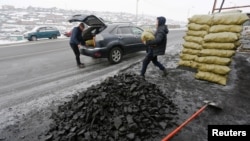Hundreds of Mongolians braved frigid weather Monday to stage a protest in the country's capital demanding that the government do more to address worsening air pollution that they fear is sickening their children and shortening their lives.
The demonstrators gathered in a public square in front of government offices, holding banners with slogans such as "Let's give fresh air to our future children,'' "Smog is silent killer'' and "We can't breathe.''
"We are desperate and we are organizing this demonstration to make authorities feel our frustration and anger,'' said Purevkhuu Tserendorj, one of the protest's organizers and a mother of two.
The air temperature hovered around minus 20 degrees Celsius (minus 4 Fahrenheit).
According to UNICEF, the United Nations' children's agency, air pollution is linked to the three diseases that have resulted in the most "lost life-years'' in Mongolia.
The agency said in February that pneumonia and other respiratory infections were among the leading causes of death among Mongolian children under the age of 5. It said that the lungs of children living in highly polluted districts of Ulaanbaatar, the capital, do not function as well as those living in rural areas, with real risks of them suffering chronic respiratory diseases when they're older.
The protesters demanded that the government increase the number of beds in hospitals that have been overcrowded with sick children and develop a plan to reduce air pollution by 80 percent by 2018. They also urged the government to install air filters in kindergartens in the capital's slum areas, which are worst-hit by the pollution.
Ulaanbaatar is one of the world's coldest capitals, with temperatures sometimes falling to -40 C (-40 F) in January, the coldest month of the year. More than half of the city's 1.3 million residents have to rely on burning raw coal, plastic, rubber tires and other materials to stay warm and cook meals in their homes. Such areas, where residents live in traditional round tents that do not have centralized heating, have been shrouded in choking smog in recent days.








